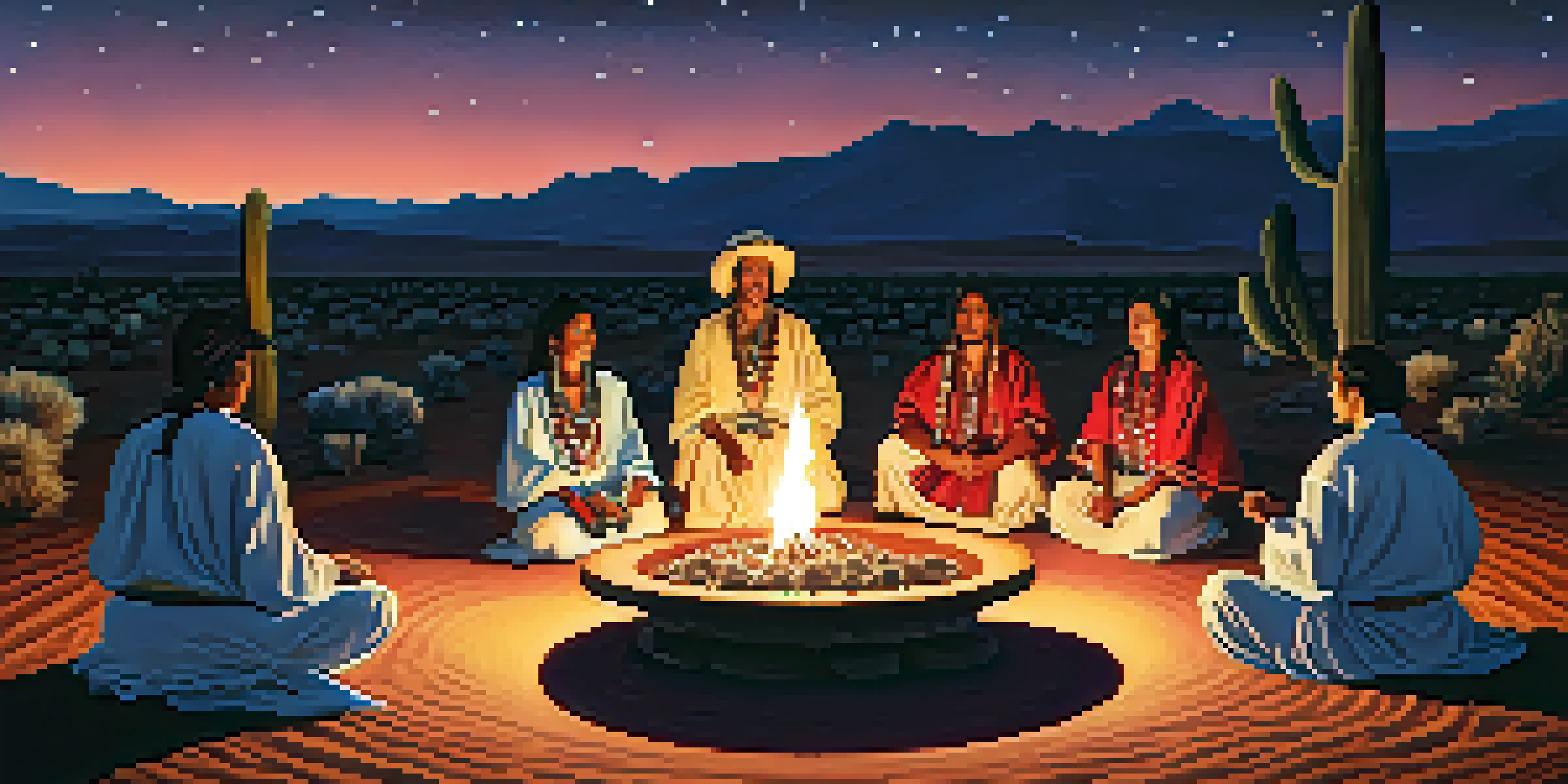Peyote Ceremonies as Linguistic Preservation Tools

Understanding Peyote Ceremonies and Their Significance
Peyote ceremonies are deeply rooted rituals practiced by various Indigenous communities, particularly in North America. They involve the use of peyote, a cactus with psychoactive properties, and serve as both spiritual and communal gatherings. Participants often engage in prayer, singing, and storytelling, all of which reinforce cultural identity and shared values.
Language is the road map of a culture. It tells you where its people come from and where they are going.
These ceremonies are not just about the consumption of peyote; they are rich with tradition and language. Through song and spoken word, participants convey stories that reflect their history, beliefs, and worldviews. This oral tradition is a key component in maintaining the languages that might otherwise fade away in today’s fast-paced, digital world.
As these ceremonies continue to be held, they provide a living context for Indigenous languages. By using their native tongues in sacred spaces, communities strengthen their linguistic heritage and foster a sense of belonging among participants.
The Role of Language in Cultural Identity
Language is more than just a means of communication; it is a cornerstone of cultural identity. For many Indigenous peoples, their language encapsulates their worldview and connection to the land. When language is lost, it isn't just words that disappear; it’s the unique perspectives and traditions embedded within those words.

Peyote ceremonies often serve as a platform for the use of native languages, reinforcing their importance in everyday life. When participants sing traditional songs or recite prayers, they are actively engaging with their heritage. This engagement fosters pride and encourages younger generations to learn and use their ancestral languages.
Peyote Ceremonies Preserve Language
Peyote ceremonies serve as a vital platform for Indigenous communities to engage with and preserve their languages through prayer, song, and storytelling.
Moreover, the act of speaking in one’s native tongue during spiritual ceremonies creates a sacred space where language thrives. It helps to pass down not only words but also the cultural nuances and stories that define a community's identity.
Peyote and the Preservation of Oral Traditions
Oral traditions are vital for the transmission of knowledge in many Indigenous cultures. Peyote ceremonies offer a unique environment where these traditions can flourish through storytelling and song. Elders often share tales that have been passed down for generations, ensuring that younger participants absorb these narratives.
When you lose a language, you lose a culture and a way of seeing the world.
By incorporating oral traditions into Peyote ceremonies, communities are actively preserving their languages. These stories often contain cultural lessons, historical accounts, and moral teachings, all of which are conveyed in the indigenous language. This practice not only nurtures the language but also strengthens the community’s bond with its history.
As participants engage with these oral traditions, they become more than just listeners; they become stewards of their language. This communal act of preservation is essential for maintaining cultural continuity in a rapidly changing world.
Challenges Facing Indigenous Languages Today
Despite the efforts to preserve Indigenous languages through Peyote ceremonies, many face significant challenges. Globalization, urbanization, and the dominance of major languages have contributed to the decline of these languages. Additionally, younger generations may feel disconnected from their linguistic roots due to modern influences.
Peyote ceremonies offer a counter to this trend by fostering a sense of community and purpose. They provide a space where language and culture can be revitalized and celebrated. However, these gatherings alone cannot solve the larger societal issues that threaten linguistic diversity.
Language is Key to Cultural Identity
For Indigenous peoples, language embodies their worldview and traditions, making its preservation essential for maintaining cultural identity.
Addressing these challenges requires a multifaceted approach, including educational initiatives and community engagement. The continued practice of Peyote ceremonies can be a vital part of this strategy, reminding community members of the importance of their language in all aspects of life.
The Intergenerational Transmission of Language
One of the most effective ways to preserve a language is through intergenerational transmission, where knowledge and language skills are passed down from elders to youth. Peyote ceremonies create a natural setting for this exchange, as they often involve participation from all age groups. Children and young adults witness and engage with their elders, learning language and culture in a meaningful context.
In these ceremonies, youth are encouraged to participate by singing songs or sharing their own stories. This inclusion fosters confidence and a sense of responsibility towards their linguistic heritage. As they witness the reverence shown to their language during these rituals, they develop a deeper appreciation for its value.
Ultimately, the Peyote ceremony becomes a living classroom where language is not just taught but experienced. This experiential learning is crucial for ensuring that Indigenous languages thrive for future generations.
Community Engagement and Language Revitalization
Community engagement plays a pivotal role in revitalizing Indigenous languages, and Peyote ceremonies are central to this effort. These gatherings not only promote spiritual well-being but also foster a sense of belonging among participants. This collective identity is essential for encouraging language use outside of ceremonial contexts.
As communities gather to celebrate their traditions, the language becomes woven into the fabric of daily life. Participants often carry the teachings and songs from the ceremonies into their homes, schools, and community events. This everyday use is vital for keeping the language alive and relevant.
Intergenerational Learning is Crucial
Peyote ceremonies facilitate intergenerational transmission of language, allowing elders to pass down linguistic and cultural knowledge to younger generations.
Moreover, as awareness of language preservation grows, communities are becoming more proactive. They are organizing language classes, cultural workshops, and events centered around their heritage, all of which are strengthened by the foundational practices established in Peyote ceremonies.
The Future of Indigenous Languages and Peyote Ceremonies
Looking ahead, the future of Indigenous languages is closely tied to the continuation of Peyote ceremonies. As more individuals recognize the importance of their linguistic heritage, these ceremonies can play a crucial role in the revitalization efforts. They offer a space for cultural exchange and reaffirmation of identity, which is essential for the survival of these languages.
The integration of modern technology and social media can also complement traditional practices. Communities can share recordings of ceremonies, songs, and teachings online, reaching a broader audience and inspiring interest in their languages and cultures. This blend of tradition and innovation can breathe new life into language preservation efforts.

Ultimately, as long as there are people willing to gather, share, and celebrate their heritage through Peyote ceremonies, Indigenous languages will have a fighting chance. The resilience of these communities and their commitment to cultural preservation will ensure that their voices continue to resonate for generations to come.